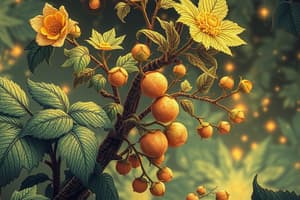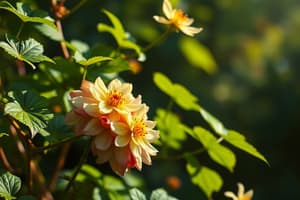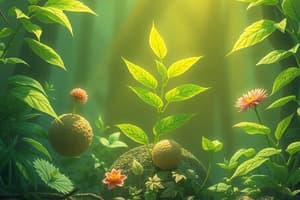Podcast
Questions and Answers
What is the process by which plants synthesize food using sunlight?
What is the process by which plants synthesize food using sunlight?
- Transpiration
- Photosynthesis (correct)
- Respiration
- Fermentation
What term is used to describe organisms that cannot produce their own food?
What term is used to describe organisms that cannot produce their own food?
- Heterotrophs (correct)
- Saprophytic
- Autotrophs
- M trophic
Why do green plants contain chlorophyll?
Why do green plants contain chlorophyll?
- To store energy as fat
- To absorb sunlight for photosynthesis (correct)
- To help in respiration
- To produce nitrogen
What role do bacteria play in nitrogen absorption by plants?
What role do bacteria play in nitrogen absorption by plants?
What is the ultimate source of energy for all living organisms?
What is the ultimate source of energy for all living organisms?
What characteristic do algae share with green plants?
What characteristic do algae share with green plants?
What happens to leaves of plants kept in darkness when exposed to sunlight later?
What happens to leaves of plants kept in darkness when exposed to sunlight later?
Cuscuta, also known as Amarbel, primarily relies on which of the following for nourishment?
Cuscuta, also known as Amarbel, primarily relies on which of the following for nourishment?
What term describes plants that digest insects for nutrients?
What term describes plants that digest insects for nutrients?
Which mode of nutrition involves absorbing nutrients from decaying matter?
Which mode of nutrition involves absorbing nutrients from decaying matter?
What is the relationship called when two organisms share shelter and nutrients?
What is the relationship called when two organisms share shelter and nutrients?
In lichens, what does the fungus provide to the chlorophyll-containing partner?
In lichens, what does the fungus provide to the chlorophyll-containing partner?
Which nutrients are essential for enriching the soil for plant growth?
Which nutrients are essential for enriching the soil for plant growth?
Why can't plants utilize atmospheric nitrogen directly?
Why can't plants utilize atmospheric nitrogen directly?
What role does Rhizobium play in relation to leguminous plants?
What role does Rhizobium play in relation to leguminous plants?
How does the association between legumes and Rhizobium benefit farmers?
How does the association between legumes and Rhizobium benefit farmers?
Flashcards
Autotrophic Nutrition
Autotrophic Nutrition
The process where organisms produce their own food using simple substances like carbon dioxide and water.
Autotrophs
Autotrophs
Organisms that can make their own food through photosynthesis.
Heterotrophs
Heterotrophs
Organisms that rely on other organisms for their food.
Chlorophyll
Chlorophyll
Signup and view all the flashcards
Photosynthesis
Photosynthesis
Signup and view all the flashcards
Sun
Sun
Signup and view all the flashcards
Nitrogen-fixing bacteria
Nitrogen-fixing bacteria
Signup and view all the flashcards
Cuscuta (Amarbel)
Cuscuta (Amarbel)
Signup and view all the flashcards
Insectivorous Plants
Insectivorous Plants
Signup and view all the flashcards
Symbiosis
Symbiosis
Signup and view all the flashcards
Lichens
Lichens
Signup and view all the flashcards
Nutrients
Nutrients
Signup and view all the flashcards
Rhizobium
Rhizobium
Signup and view all the flashcards
Rhizobium-Legume Symbiosis
Rhizobium-Legume Symbiosis
Signup and view all the flashcards
Study Notes
Nutrition in Plants and Organisms
- Autotrophic Nutrition: Organisms that make their own food from simple substances (e.g., plants) are called autotrophs.
- Heterotrophic Nutrition: Organisms that obtain food from other organisms (e.g., animals) are called heterotrophs.
- Photosynthesis: Plants use chlorophyll to capture sunlight's energy and synthesize food (carbohydrates) from carbon dioxide and water. This process occurs in the presence of sunlight.
- Chlorophyll: A green pigment in leaves that absorbs sunlight for photosynthesis.
- Sun as Ultimate Energy Source: The sun is the primary source of energy for all living things; energy captured by photosynthesis is transferred through the food chain.
- Iodine Test (For Starch): Used to identify the presence of carbohydrates (starch) in leaves, indicating if photosynthesis has occurred.
Other Nutrition Types
-
Photosynthesis in Non-Green Leaves: Plants with leaves containing pigments besides green chlorophyll can still perform photosynthesis.
-
Nitrogen Uptake: Plants cannot absorb atmospheric nitrogen directly. Soil bacteria convert atmospheric nitrogen into a usable form that plants can take up with water and other nutrients. Fertilizers offer an alternative source of soil nitrogen.
-
Algae: Microscopic, photosynthetic organisms found in water bodies, commonly green in color due to chlorophyll.
-
Parasitic Plants (Cuscuta): Plants that do not produce their own food but obtain nutrients from a host plant, lacking chlorophyll.
-
Insectivorous Plants: Carnivorous plants that supplement their nutrient requirements by trapping and digesting insects.
Saprotrophic Nutrition
- Fungi: Organisms that acquire nutrients from dead and decaying matter are called saprotrophs with a saprotrophic mode of nutrition. This mode involves absorbing nutrients from decomposing materials.
Symbiotic Relationships
- Symbiosis: A close relationship between different organisms where both benefit.
- Fungi and Plant Roots: Some fungi live within plant roots, receiving nutrients from the plant and providing the plant with water and essential minerals in return.
- Lichens: A symbiotic partnership between an alga (that photosynthesizes) and a fungus (that provides shelter and absorbs nutrients).
Plant Nutrients
- Soil Enrichment: Soil needs regular addition of nutrients (e.g., nitrogen, potassium, phosphorus) from fertilizers and manures to support plant growth.
- Nitrogen Fixation: Nitrogen gas in the air is converted to a usable form through the action of nitrogen-fixing bacteria like Rhizobium. These bacteria often live in the root nodules of legumes (e.g., beans, peas). This symbiotic relationship is advantageous for farmers.
Studying That Suits You
Use AI to generate personalized quizzes and flashcards to suit your learning preferences.




